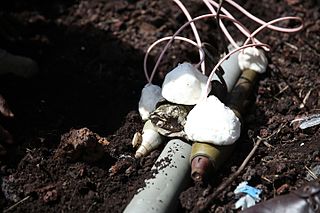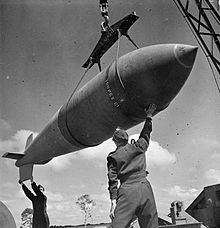
RDX (abbreviation of "Research Department eXplosive" or Royal Demolition eXplosive) or hexogen, among other names, is an organic compound with the formula (CH2N2O2)3. It is white, odorless and tasteless, widely used as an explosive. Chemically, it is classified as a nitroamine alongside HMX, which is a more energetic explosive than TNT. It was used widely in World War II and remains common in military applications.

An explosive is a reactive substance that contains a great amount of potential energy that can produce an explosion if released suddenly, usually accompanied by the production of light, heat, sound, and pressure. An explosive charge is a measured quantity of explosive material, which may either be composed solely of one ingredient or be a mixture containing at least two substances.

Plastic explosive is a soft and hand-moldable solid form of explosive material. Within the field of explosives engineering, plastic explosives are also known as putty explosives or blastics.

Trinitrotoluene, more commonly known as TNT, more specifically 2,4,6-trinitrotoluene, and by its preferred IUPAC name 2-methyl-1,3,5-trinitrobenzene, is a chemical compound with the formula C6H2(NO2)3CH3. TNT is occasionally used as a reagent in chemical synthesis, but it is best known as an explosive material with convenient handling properties. The explosive yield of TNT is considered to be the standard comparative convention of bombs and asteroid impacts. In chemistry, TNT is used to generate charge transfer salts.

Pentaerythritol tetranitrate (PETN), also known as PENT, pentyl, PENTA, TEN, corpent, or penthrite, is an explosive material. It is the nitrate ester of pentaerythritol, and is structurally very similar to nitroglycerin. Penta refers to the five carbon atoms of the neopentane skeleton. PETN is a very powerful explosive material with a relative effectiveness factor of 1.66. When mixed with a plasticizer, PETN forms a plastic explosive. Along with RDX it is the main ingredient of Semtex and C4.

Royal Ordnance Factory (ROF) Bridgwater was a factory between the villages of Puriton and Woolavington in the Sedgemoor district of Somerset, England that produced high explosives for munitions. It was slightly above sea level, between the 5-and-10-metre contour lines on Ordnance Survey maps. BAE Systems closed it when decommissioning was completed in July 2008.

Amatol is a highly explosive material made from a mixture of TNT and ammonium nitrate. The British name originates from the words ammonium and toluene. Similar mixtures were known as Schneiderite in France. Amatol was used extensively during World War I and World War II, typically as an explosive in military weapons such as aircraft bombs, shells, depth charges, and naval mines. It was eventually replaced with alternative explosives such as Composition B, Torpex, and Tritonal.

Tritonal is a mixture of 80% TNT and 20% aluminium powder, used in several types of ordnance such as air-dropped bombs. The aluminium increases the total heat output and hence impulse of the TNT — the length of time during which the blast wave is positive. Tritonal is approximately 18% more powerful than TNT alone.

A blockbuster bomb or cookie was one of several of the largest conventional bombs used in World War II by the Royal Air Force (RAF). The term blockbuster was originally a name coined by the press and referred to a bomb which had enough explosive power to destroy an entire street or large building through the effects of blast in conjunction with incendiary bombs.

Composition B, also known as Hexotol and Hexolite, is a high explosive consisting of castable mixtures of RDX and TNT. It is used as the main explosive filling in artillery projectiles, rockets, land mines, hand grenades and various other munitions. It was also used for the explosive lenses in the first implosion-type nuclear weapons developed by the United States.
Aphrodite was the World War II code name of a United States Army Air Forces operation to use worn out Boeing B-17 Flying Fortress and Consolidated PB4Y bombers as radio controlled flying bombs against bunkers and other hardened or reinforced enemy facilities. A parallel project by the United States Navy was codenamed Anvil. The missions were not generally successful, and the intended targets in Europe were either overrun by the ground advance of Allied troops or disabled by conventional attacks by aircraft.
High Blast Explosive, or HBX, is an explosive used as a bursting charge in missile warheads, mines, depth bombs, depth charges, and torpedoes.
Minol is a military explosive developed by the Admiralty early in the Second World War to augment supplies of trinitrotoluene (TNT) and RDX, which were in short supply. The aluminium component in Minol significantly prolongs the explosive pulse, making it ideal for use in underwater naval weapons where munitions with a longer explosive pulse are more destructive than those with high brisance. Minol cannot be used in weapons fired from gun barrels because there is a risk of detonation when subjected to over 250 gs of acceleration. Initially, three Minol formulas were used. All percentages shown are by weight:

The Royal Gunpowder Mills are a former industrial site in Waltham Abbey, England. It was one of three Royal Gunpowder Mills in the United Kingdom. Waltham Abbey is the only site to have survived virtually intact.
Composition H-6 is a melt-cast military aluminized high explosive. H-6 was developed in the US
Holston Army Ammunition Plant (HSAAP) manufactures Research Department Explosive (RDX) and High Melting Explosive (HMX) for ammunition production and development. It is a government-owned and contractor-operated (GOCO) facility that is part of the US Army Joint Munitions Command.
Hexanite was a castable German military explosive developed early in the 20th century before the First World War for the Kaiserliche Marine, intended to augment supplies of trinitrotoluene (TNT), which were then in short supply. Hexanite is slightly less powerful than TNT on its own. The most common hexanite formula was 60% TNT and 40% hexanitrodiphenylamine.

The SB 1000 (Spezialbombe) was a luftmine used by the German Luftwaffe during World War II.
Trialen was an explosive developed in Germany. It was used during World War II in the V-1 flying bomb and Arado E.377 glide bomb, among other weapons, as an enhanced blast explosive. Trialen was the German equivalent of the British explosive Torpex, though its production was hindered by a shortage of the aluminium powder that was added to increase its explosive power.












